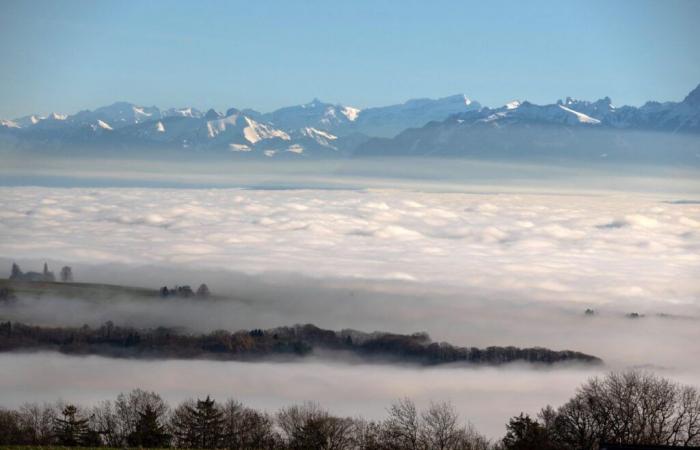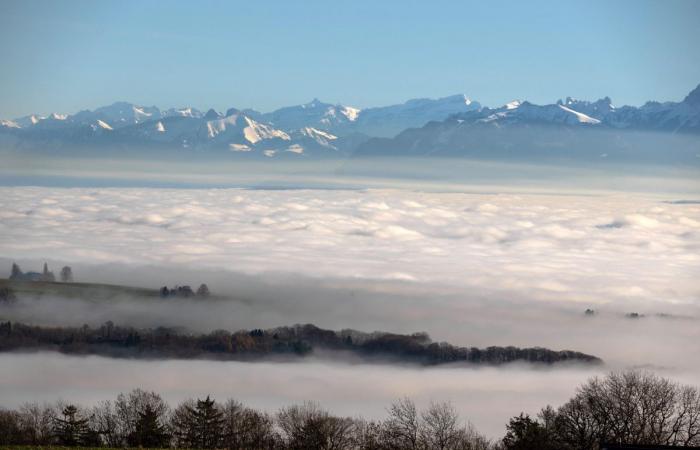Weather in the canton –
Omnipresent this fall, the fog takes over
Unless you live between Vevey and Bex or above 1000 meters, it has been impossible to escape it for a month, after a “lull” of two years.
Posted today at 5:57 p.m.
This fall, the fog invaded La Côte more than usual, like here in Arzier-Le Muids.
PATRICK MARTIN
Subscribe now and enjoy the audio playback feature.
BotTalk
- The fog has been omnipresent since mid-October. But it is more a return to normal after two mild autumns than an exceptional year.
- Data from weather stations indicate that it is in Payerne and Mathod that the sunshine has been the rarest since the 1is November.
- You have to live between Vevey and Bex or above 1000 meters to escape it.
- In Switzerland, the Zealand region remains one of the worst in this area according to MeteoNews.
This fall, you had to live between Vevey and Bex or above 1000 meters above sea level to enjoy the pleasure of an Indian summer, albeit a late one. Elsewhere, the sun capital of the Vaudois has been undermined for a month by the omnipresence of thick fog.
The situation is all the more dire as it comes after two rather lenient years. Meteorologist at MeteoNews, Vincent Devantay explains that 2024 brought together between the end of summer and the first part of autumn all the conditions necessary for the formation of the stratus: frequent rains in September and October, waterlogged soils and atmospheric overall very humid. “From a hydrological point of view, 2023-2024 is one of the wettest years since measurements began.”
The negative effect of the anticyclone
And then, the anticyclone which set in permanently from the weekend of October 19-20 froze the situation. Persistent high pressure has been suppressing humidity at low altitudes for three weeks. And at this time, the sun is no longer strong enough to reverse the trend. “The stratus was formed between the warm air mass and the cold air mass which were unable to mix,” underlines the specialist.
Basically, it was cold and humid in the plains, hot and dry at altitude. Concretely? Weather stations recorded 95% humidity and 9°C on a November day at 2 p.m. in Payerne (456 meters) and 35% humidity and 17°C at the same time in the Vallée de Joux (1020 meters). “In a classic weather situation, the temperature drops by 0.6 per 100 meters of altitude,” underlines Vincent Devantay.
The final factor, the absence of wind, influenced the duration of this gray situation. Until this Tuesday, there has been virtually no strong breeze or southwest wind to dissipate the cloudiness.
As a result, the sunshine statistics for the first eleven days of November speak for themselves. If Payerne once again compares poorly with La Dôle (twenty-three hours compared to ninety-four hours), Mathod, in the North of Vaud, is even less well off with barely fourteen hours of sunshine during this same period.
“Even if Zealand does worse, the Orbe plain and the Venoge valley are renowned in this regard. In the second case, we find ourselves in a basin which concentrates humidity where cold air stagnates and where there is little wind,” continues the meteorologist.
The Riviera-Chablais exception
Other plains do not experience the same reality. Starting with Chablais. This is because the air is drier and the topography is very different. In addition, the thermals present in the Rhône valley limit the formation of fog. “If there is any, it is stratus which is found between 1200 and 1500 meters, which can sometimes penetrate as far as the bend of the Rhône,” notes Vincent Devantay.
Moreover, the “old-timers” readily repeat that the fog, fixed these days between 700 and 1200 meters, has increased in height since the end of the 20th century.e century. And that, under the effect of the wind, it conquered other regions of the canton.
Simple impression or reality? “If we assume that the wind has blown regularly in recent years, we can come to this conclusion. But this is difficult to verify, as weather stations do not record the upper limit of the stratus.”
What concerns the meteorologist more, however, is the particular case posed by La Côte this fall. Usually little affected, the Nyon region displays a share of sunshine which has nothing to envy of Broye or the North of Vaud… The explanation perhaps lies in the weak wind or in the tendency to foehn in the Alps which has pushed the humidity to western Lake Geneva.
Classic situation
Whatever the case, Vincent Devantay refutes the idea of an exceptional year. “November is generally the month with the most fog. The situation is therefore quite classic for the season. But people may have forgotten it, after two special autumns.”
What is established is that since October 17, Yverdon has experienced three times more days under stratus than during the entire past year.
Generally speaking, fog has been less present since the beginning of the 21st century.e century. This is mainly explained by more dynamic weather situations, either governed by more marked low pressure conditions which thwart the formation of fog or promote its dissipation. Beyond a trend towards drier conditions, it is nevertheless difficult to attribute this state of affairs to the effects of global warming alone.
Less pollution than in the past, however, has an impact on the situation. “The reduction in sulfur dioxide emissions limits the formation of fog,” assures Vincent Devantay.
Over the last two days, the north wind has given the entire canton some nice sunny spells. A lull, in fact. “The fog will probably return at the end of the week. Then it should be dissipated next week by the arrival of disturbed or even agitated conditions,” predicts the meteorologist.
But the season is still long. In the plains, you will have to wait until February to be sure of seeing the sun at the end of the tunnel.
“Latest news”
Want to stay on top of the news? “24 Heures” offers you two appointments per day, directly in your email box. So you don’t miss anything that’s happening in your Canton, in Switzerland or around the world.
Other newsletters
Log in
Did you find an error? Please report it to us.
4 comments







